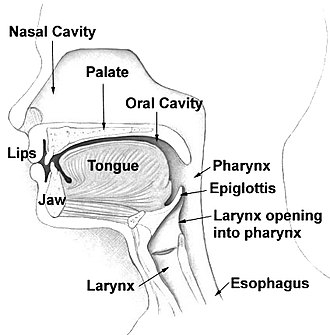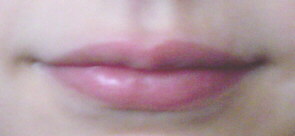Human mouth


Human Mouth[edit]
The mouth, a central component in human anatomy, is the primary entryway to the alimentary canal and receives both food and saliva. Beyond its crucial role in the digestive system, the mouth is integral to human communication. While the foundational elements of voice production occur in the throat, the tongue, lips, and jaw also significantly contribute to the diverse range of sounds present in human speech.
The mouth's interior is usually moist, coated by a mucous membrane, and houses the teeth. The transition from the mucous membrane to the external skin is marked by the lips.
Anatomy[edit]
Mouth Cavity[edit]
The mouth cavity, or the oral cavity, is the initial section of the mouth. Its boundaries include:
- Laterally and anteriorly: Alveolar process (home to the teeth)
- Posteriorly: Isthmus of the fauces
- Superiorly (roof): Combination of the hard and soft palates
- Inferiorly (floor): Constructed by the mylohyoid muscles and is predominantly occupied by the tongue.
Orifice[edit]
When closed, the mouth's orifice forms a boundary line separating the upper and lower lips. This line's appearance can change based on facial expressions—forming an upward-opening curve during a smile and a downward-opening one while frowning. A permanently downturned mouth can be a standard facial feature. In certain cases, such as in Prader-Willi syndrome, a downturned mouth is a notable characteristic.
Innervation[edit]
The mouth's innervation is intricate, with the teeth and the periodontium (tissues supporting the teeth) receiving signals from the trigeminal nerve's maxillary and mandibular divisions.
- Maxillary Teeth: These, along with their periodontal ligament, are served by the superior alveolar nerves—divisions of the maxillary segment.
- Mandibular Teeth: These and their periodontal ligament receive innervation from the inferior alveolar nerve, part of the mandibular division.
A detailed breakdown of the oral mucosa's innervation is vast, with the various regions receiving signals from a combination of the infraorbital nerve, greater palatine nerve, nasopalatine nerve, sublingual nerve, mental nerve, and the buccal nerve.
Development[edit]
Developmental features of the mouth include the philtrum, a vertical indentation in the upper lip. It forms when the nasomedial and maxillary processes meet during embryonic development. Failure in their complete fusion can lead to conditions like hare lip and/or cleft palate. Moreover, the nasolabial folds, deep tissue creases running from the nose to the mouth's sides, often become more prominent with age.
Function[edit]
Central to various vital processes, the mouth facilitates essential functions:
- Eating and Drinking: It plays a pivotal role in mastication (chewing) and the intake of liquids.
- Breathing: Serving as an auxiliary respiratory passage.
- Communication: Key for speech production and articulation.
In addition, newborns inherently possess a sucking reflex, prompting them to suckle for nutrition.
See Also[edit]
- Digestive system
- Human anatomy
- Speech production
- Facial expressions
- Head and neck anatomy
- Mouth breathing
- Index of oral health and dental articles
- List of basic dentistry topics
References[edit]
<references group="" responsive="0"></references>
Ad. Transform your life with W8MD's Budget GLP-1 injections from $75


W8MD offers a medical weight loss program to lose weight in Philadelphia. Our physician-supervised medical weight loss provides:
- Weight loss injections in NYC (generic and brand names):
- Zepbound / Mounjaro, Wegovy / Ozempic, Saxenda
- Most insurances accepted or discounted self-pay rates. We will obtain insurance prior authorizations if needed.
- Generic GLP1 weight loss injections from $75 for the starting dose.
- Also offer prescription weight loss medications including Phentermine, Qsymia, Diethylpropion, Contrave etc.
NYC weight loss doctor appointmentsNYC weight loss doctor appointments
Start your NYC weight loss journey today at our NYC medical weight loss and Philadelphia medical weight loss clinics.
- Call 718-946-5500 to lose weight in NYC or for medical weight loss in Philadelphia 215-676-2334.
- Tags:NYC medical weight loss, Philadelphia lose weight Zepbound NYC, Budget GLP1 weight loss injections, Wegovy Philadelphia, Wegovy NYC, Philadelphia medical weight loss, Brookly weight loss and Wegovy NYC
|
WikiMD's Wellness Encyclopedia |
| Let Food Be Thy Medicine Medicine Thy Food - Hippocrates |
Medical Disclaimer: WikiMD is not a substitute for professional medical advice. The information on WikiMD is provided as an information resource only, may be incorrect, outdated or misleading, and is not to be used or relied on for any diagnostic or treatment purposes. Please consult your health care provider before making any healthcare decisions or for guidance about a specific medical condition. WikiMD expressly disclaims responsibility, and shall have no liability, for any damages, loss, injury, or liability whatsoever suffered as a result of your reliance on the information contained in this site. By visiting this site you agree to the foregoing terms and conditions, which may from time to time be changed or supplemented by WikiMD. If you do not agree to the foregoing terms and conditions, you should not enter or use this site. See full disclaimer.
Credits:Most images are courtesy of Wikimedia commons, and templates, categories Wikipedia, licensed under CC BY SA or similar.
Translate this page: - East Asian
中文,
日本,
한국어,
South Asian
हिन्दी,
தமிழ்,
తెలుగు,
Urdu,
ಕನ್ನಡ,
Southeast Asian
Indonesian,
Vietnamese,
Thai,
မြန်မာဘာသာ,
বাংলা
European
español,
Deutsch,
français,
Greek,
português do Brasil,
polski,
română,
русский,
Nederlands,
norsk,
svenska,
suomi,
Italian
Middle Eastern & African
عربى,
Turkish,
Persian,
Hebrew,
Afrikaans,
isiZulu,
Kiswahili,
Other
Bulgarian,
Hungarian,
Czech,
Swedish,
മലയാളം,
मराठी,
ਪੰਜਾਬੀ,
ગુજરાતી,
Portuguese,
Ukrainian


